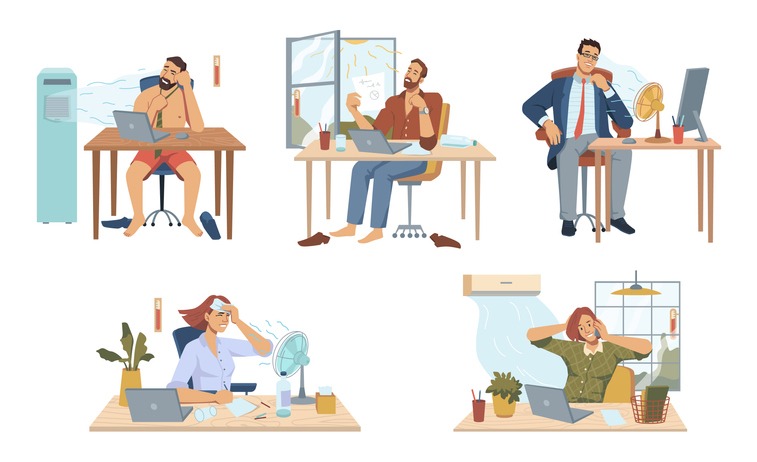
High temperatures pose risks to workers’ safety and can also lead to decreased productivity – Moreover, the inadequate readiness of buildings in the UK emphasizes the urgency for prompt solutions
CREDIT: This is an edited version of an article that originally appeared on The Guardian
As the climate crisis continues to reshape the global landscape, the imperative for change extends beyond individual actions and permeates into the very fabric of our workplaces. In the United Kingdom, a nation committed to sustainability, the question arises: How can workplaces evolve to address the climate crisis?
While there is a minimum legal temperature for UK workplaces of 16C in offices, there is no maximum legal temperature. The Health and Safety Executive states that all employees are entitled to “an environment where risks to their health and safety are properly controlled”, but these rights aren’t always taken into consideration in the workplace.
Dan Shears, the national health, safety and environment director for the GMB trade union, says its call for a maximum working temperature is “nothing to do with closing workplaces – it’s about putting the responsibility on employers to make workplace temperatures bearable. We need a similar approach to the existing regulations on noise, [so that] action is taken at specific temperatures.”
The risks to worker health are clear. Looking at workplace compensation claims submitted to the California Workers’ Insurance Agency from 2000 to 2017, Behrer has found “if you go to work on a day that’s above 100F [37.8C], you’re 10 to 15% more likely to injure yourself at work.
“That’s coming not only from the more obvious injuries – heatstroke, dehydration – but also because getting dehydrated, even if that doesn’t become an acute injury, [makes you] more likely to get injured if you’re working in a dangerous environment.”
In a heatwave, the obvious solution is to stay cool by any means. Behrer says: “The ability of air conditioning to reduce the negative consequences of heat exposure is, from a purely efficient standpoint, unmatched.” However, he adds: “There are costs to air conditioning: increased electricity demand and localised heating effects from the air conditioning units themselves.”
Local doesn’t just mean the steamy back-end of a rumbling aircon unit. In June, when temperatures topped 30C (86F) in some parts of the UK, the National Grid had to fire up a Ratcliffe-on-Soar coal plant, in part due to a surge in the use of air-conditioning units.
The solution is not to do away with air conditioning altogether, Behrer says, but rather optimise it, flagging the importance of “improvements in electricity generation and transmission that facilitate the use of air conditioning, without increasing fossil-fuel emissions to generate that electricity”.
Meanwhile, Greenpeace advocates the use of heat pumps as a versatile option. Its UK climate campaigner, Georgia Whitaker, says: “Since they can be used for both heating and cooling, they’re a much more energy-efficient alternative.
“As long as the office space is properly insulated – which will also help keep the building cooler on hot days – then heat pumps will be much cheaper to run both for heating in winter and cooling in the summer and will slash emissions in the process. It’s win-win.”
But there is more to cooling offices than filling them with trinkets and tools. Ward explains we need to look elsewhere to resolve issues of overheating at work: “Most of the problems we face in dealing with heat are around our buildings. Particularly in the UK, we have a building stock that is both bad at keeping the heat in in the winter and bad at keeping the heat out in the summer.”
Solutions should come from the buildings themselves, rather than the appliances we use to cool them. “We need external shutters and blinds that can be brought down in the middle of the day. And we should start thinking seriously about painting external surfaces, particularly roofs.” That’s how Sheffield could one day begin to resemble Santorini, and Manchester mutate into Mykonos.
Behrer cites statistics that show tree canopy cover in US cities has been proven to make central areas cooler. “Temperatures can vary as much as 18F [10C] within the city limits just based on whether or not you’re at an area that has a lot of tree cover or an area that has been totally denuded. Things like that make a big difference in cooling and really reduce your subsequent demand for climate control.”
Tom Rigby, a GMB health and safety officer, says: “The main danger in hot weather is heat stress. GMB advice is for workers to take regular breaks in a cooler place and have access to plenty of cold or iced drinks.”
In California, the state has imposed a policy requiring employers to introduce cooling activities throughout the day. “At 85F [29.4C], they have to offer a rest break, at 90F [32.2C] they have to offer rest break and shade structures,” says Behrer. “At 95F [35C] everyone has to work in a buddy system so that if something happens, they can be supported.
“We found that that policy was very effective in reducing the sensitivity of injuries to high temperatures. And so those kinds of things can be effective in reducing the negative consequences.”


Be the first to comment